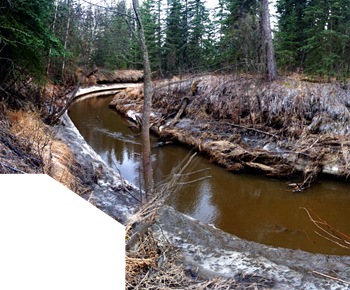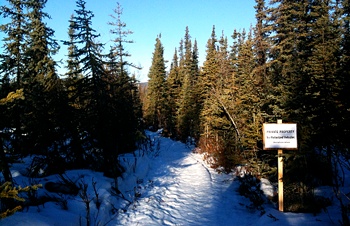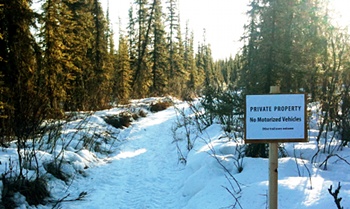The Creek has been flowing for what seems like months now, but up until a couple days ago it was a foot and a half of water flowing on top of a frozen Creek bed. Over the last two days the water level has dropped at least three feet, probably because the ice underneath crumbled and melted away. Now there’s a thick band of ice along the banks, hanging above the water flowing through the middle.
This is all very different from the past two years when the water and ice all broke up at the same time, resulting in a very rapidly moving Creek filled to the top of the banks with an enormous amount of water and crushed ice. I was looking forward to that this year, but it’s been such a mild breakup that seeing the Creek suddenly drop down to summer levels is a little disappointing.
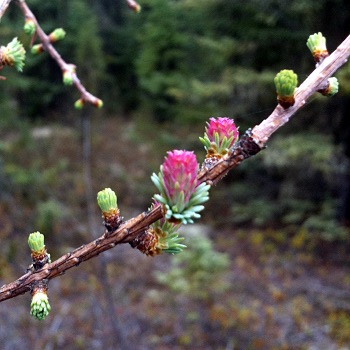
Tamarack buds
At least it’s not snowing anymore and things are starting to get green. Most of the birch trees and shrubs have buds that are just beginning to open. There are also several large Tamarack (American larch, Larix laricina) around that are beginning to show signs of leafing out. Tamarack is one of my favorite trees; a deciduous conifer that looks like an evergreen tree in summer but drops it’s leaves in winter. I’d never looked carefully at the buds in the spring—the photo isn’t the greatest representation, but what you’re looking at are the bright green leaf buds, and purplish buds that I think will turn into cones. They’re a very striking tree once their bright green foliage comes out, and I’m eager to see what happens with the cool purple buds that dot the spindly branches right now.
The photo of the Creek at the top of the post (click on the image for a larger view) is a set of nine photos joined together by the AutoStitch iPhone app into a panorama. You can see that it should have been composed of ten photos so the lower left corner could be filled in. In my mind I’d envisioned a sort of running band of photos along the Creek, but it didn’t turn out quite the way I saw it.
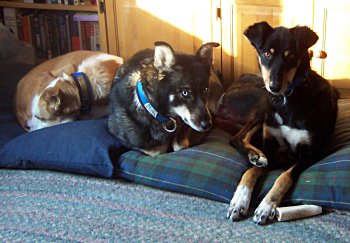
Piper, Kiva, Koidern
Kiva died today as a result of an inflammatory disease that we couldn’t bring under control, and the pain this was causing her. She was a little over seven years old.
We got Kiva from the Fairbanks Animal Shelter in November 2004 when she was only a year and a half old. She’d been abandoned because she “didn’t want to be a sled dog” by the same musher who had previously abandoned Piper. Throughout her life she was a super energetic dog that had a hard time staying still, loved sprint racing, and was the best fetching dog I’ve ever seen. She was great with people, and seemed to be completely in love with the cats (our old cats Ivan and Alexi and the new kittens we got late last year). We sometimes called her “devil dog” for her personality, dark coloration and bright blue eyes. Unfortunately, she didn’t get along with Piper, and started four major fights. The latest fight, two weeks ago, happened in the house, and we think it was because her pain was increasing. We finally decided that it was time to say goodbye.
As much as we love Kiva and all the energy she brought to our household, we struggled with her disease and her fighting. We agonized about euthanizing her for years, and even more over the last couple weeks since her latest fight, and we finally decided that it isn’t fair to her to be living with enough pain that she’s intolerant of the other dogs and can’t go to the bathroom normally, and it’s not fair to the other dogs (or us) to be placed in a situation where they might get injured or killed. I wish there had been something else we could have tried, some treatment or medication that would have made her happy and peaceful.
Some things I remember about her:
- Whenever she was excited she’d run in counter-clockwise circles, over and over again.
- She liked coming with me when I went out to the red cabin to get beer.
- We played fetch with her using chunks of wood when we lived on Whistling Swan and bought a Chuck-It so we could throw it all the way down the dog yard or driveway here on Railroad Drive.
- She loved it when we changed the kitchen garbage.
- She was the only dog that would howl, usually before races.
- She hated water and would go well out of her way to avoid stepping in puddles.
- She went absolutely crazy when there were dogs outside the dog yard.
- She got so excited before races that she’d chew the lines and would slam forward, rock back and slam forward the entire time at the line.
- She was a nervous little dog that scared easily.
We miss her.
Last weekend we had some ATVs on the rapidly melting trail, so I made a pair of signs (PDF, 13Kb) to mark it. I have my doubts as to whether these will have the desired effect, but I don’t really want to block the trail to all users, and this should be sufficient.
The signs read:
They’re just paper stapled to plywood, so eventually we’ll need to get something more weather proof. Maybe black text printed onto acetate, with a florescent file folder stapled underneath? Unfortunately, I have a feeling the most likely form of damage will come from humans, rather than the elements.
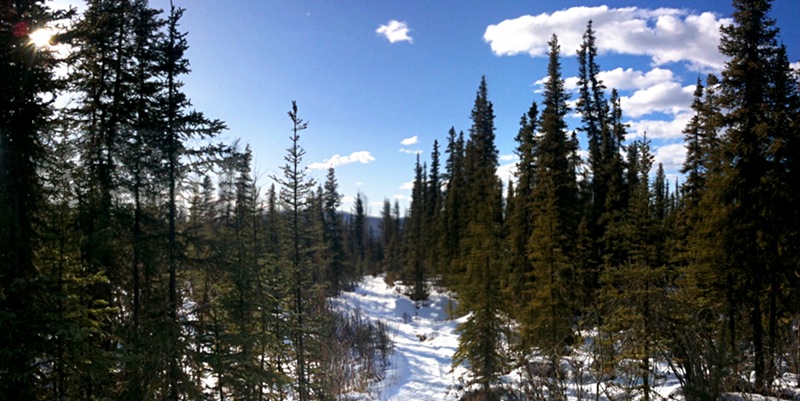
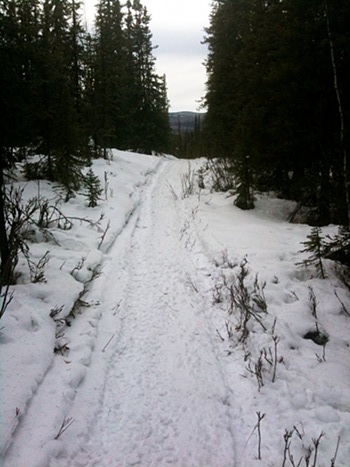
ATV trail damage
Went for a walk with the dogs on our property today and discovered some ATV’s ripped up the trail. I don’t think the damage is permanent, since the ground is still frozen, but it still makes me angry. I need to figure out a way to mark, and probably block, the trail for non-motorized uses. If the people who rode up there today are any indication, ATV riders are too fucking stupid to recognized a narrow, non-motorized trail when they see one. The photo doesn’t make it as obvious as it is in person, but their treads are entirely off the trail and in the vegetation along the sides.
It only takes one jackass to turn opinion against all ATV riders; let’s hope the rest of them show some respect.
